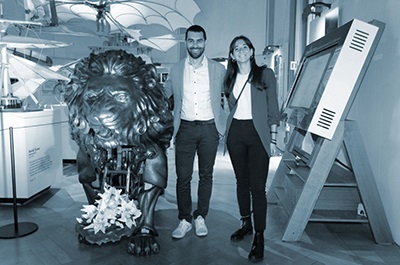
Leonardo da Vinci is considered one of the most prodigious intellectuals of all time, as his works covered several different fields of art, architecture, engineering, and natural sciences. According to some ancient writings, in 1515 Leonardo had designed and fabricated an autonomous machine resembling a lion. The robot, given as a gift to the king of France, was able to walk on its four legs and open its chest while extracting a bouquet of flowers out of it. Very few remains of the project drawings arrived to these days, and the limited documentation we have about it comes from indirect testimonies.
The museum Leonardo3 is dedicated at conveying the genius of Leonardo. In its laboratory, Leonardo’s drawings and writings are studied in detail, along with the records available about his work. The machines are then recreated in detail, with the caution of adopting only the technology that was available to Leonardo himself in the 16th century.
In occasion of the museum's 10th anniversary, the robotic lion was introduced to its collection. The project of the robot, designed and manufactured by the team led by the museum’s scientific director Edoardo Zanon, aimed at recreating Leonardo's lion machine basing on the very few information available about its original functioning. The dept. of Mechanical Engineering of Politecnico di Milano, with the participation of Ing. Michele Vignati and Ing. Francesca Palanza, was involved in the design process with the development of a virtual model of the robot.
The design was quite challenging, in fact the movement of the machine could only be powered by mechanical elements, with no hydraulics, pneumatics, nor electronics.
The result is a 180 kg, four-legged robot, able to walk 5-6 steps and then open its chest. The machine is powered by two spiral springs connected to the legs driving shaft. The legs consist of systems of rigid bodies and are put in motion by two gear mechanisms, one for each side of the robot. The legs and gears on the two sides of the robot are perfectly identical, but their mechanisms have a specific phase difference that optimizes their combined action and maximizes the stride length for a certain amount of power. The springs are loaded by being rolled around the shaft, and, when released, they suddenly unwind transferring power to the gear mechanisms, thus putting the robot in motion. To smoothen the behavior of the torque generated by the springs, a flywheel is added to the robot, connected to the driving shaft. Its high inertia moment has the effect of eliminating the force irregularities thus improving the functioning of the mechanisms and the whole gait of the robot, and allowing it to distribute the power available over a longer time span. These results were obtained by implementing and simulating a multibody model of the robot with the aid of the multibody environment Simulink Simscape-Multibody. The digital twin of the robot allowed to optimize the walking motion by tuning the kinematics of the legs, defining the joint position and synchronizing front and rear, left and right legs. Moreover, experimental tests were conducted on the actuating springs in order to characterize their behavior.
To see the robot in action visit the museum Leonardo3.
